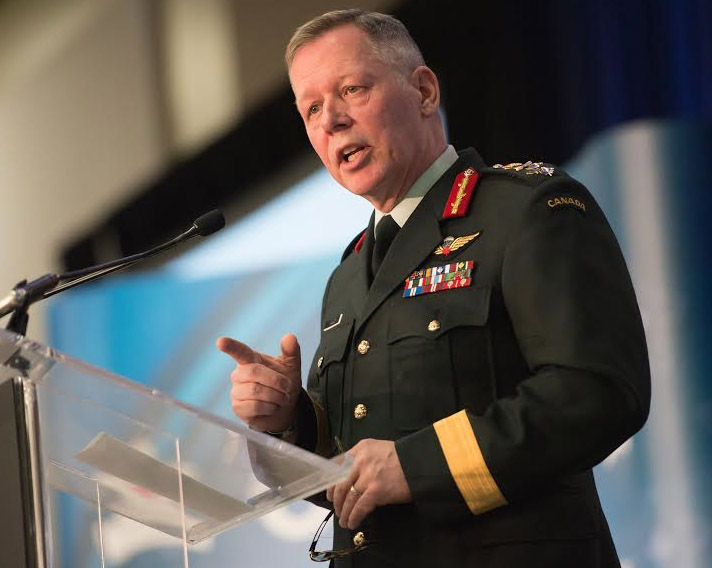
Chief of the defence staff, General Jonathan Vance addressed the Senate subcommittee on Veterans Affairs in April. [DND]
Appearing before the Senate Subcommittee on Veterans Affairs, General Jonathan Vance said recruitment, training and treatment of Canadian Armed Forces personnel is “at a turning point.” It has to be.
“I think it’s a truism that if you leave well, content, satisfied and looking back on your career,” he said, “then you will provide more of a positive reinforcement to those who may wish to join.
“If people don’t think that they’re being treated well, that we are not looking after them, then they won’t come and work for us and they won’t willingly risk their lives. If we cannot attract and retain the talent we need, then we won’t have success on operations. It’s that simple.”
Treating military retirees right is also the right thing to do, he added.
“If our policies aren’t doing what they’re supposed to be doing, which is to properly support and administer those people who defend our country, then the policies need to change and we’re going to change them.”
Canada has faced plenty of criticism over how it treats its veterans. Aside from the issues of long-term compensation for the ill and injured, retiring military members have been facing crippling delays in the transition between their military paycheques and their pensions.
This came to a head with the story of retired air force sergeant Tricia Beauchamp, a two-time cancer survivor and single mother who was evicted from her home while she was fighting with bureaucrats for her military severance, pensions and benefits.
Her case highlighted a military pension backlog that CBC reported peaked at some 13,000 files last year and prompted a flood of complaints.
Vance told the Conference of Defence Associations’ annual symposium in February that he planned to change the way military careers are managed and concluded. Now he appears to be putting meat on the bones of that promise.
“When I hear stories from my people about how they’ve gone for weeks or even months without the pension they’ve earned through their service, well, senators, disappointed doesn’t even come close to describing how I feel,” he said.
“DND, the Armed Forces and Veterans Affairs are working on converging these two systems. We have direction and intent from both of our ministers to close the seams and that’s what we will do.”
Promises, promises. Forgive jaded veterans and prospective retirees if they claim to have heard it all before. But there are a couple of reasons why, this time, the promises to improve their collective lot might be different.
Between his Operation Honour initiative aimed at eliminating sexual harassment, and efforts to change the way the CAF recruits and treats personnel, Vance has made revamping military human resources his primary mission, the one area in which he can leave a legacy.
He wasn’t given much of an option. The federal government has deferred spending on military equipment, ensuring that any significant changes in defence capability are years away, well beyond his reach.
With the traditional three-year window of his tenure already more than half closed, Vance has limited time to achieve the impact he wants.
Veterans’ rights have received a lot of lip service over the past century—more, some argue, than concrete action. Without a constant presence in the public spotlight, it is relatively easy for successive governments to sweep veterans’ issues under the rug or defer them to another day. Governments change; news comes and goes; priorities ebb and flow; policies shift.
But recruitment—fundamental to a viable military—is barely keeping pace with attrition, and women aren’t enlisting in the numbers anticipated. And those may just be the incentives needed to turn Vance’s proposals into reality.
One can argue the pros and cons of this aircraft over that aircraft, the need for ships now or later, the nuts and bolts of military function. But the recruitment of rank and file is the most basic element of national defence, security and sovereignty, and not so easy for governments to defer or ignore.
In March, the federal government budgeted $624 million more for veterans’ programs over the next five years, most of it aimed at easing outgoing soldiers’ transitions to civilian life.
Vance told the senators he is now “professionalizing” the system by which members are retired, closing gaps between responsible departments and agencies, and streamlining the process.
He is phasing out the Joint Personnel Support Unit, which now performs many discharge functions after it was created during the Afghanistan war to address the needs of ill and injured soldiers. And he is reviving the Forces’ defunct personnel administration branch.
“From the moment one of my service members is ready to retire or must medically retire, this [new] unit will have them well in hand,” said the general. “And if an individual member’s situation doesn’t fit the policy, then we’ll work with that member and we’ll customize the solution to that individual.
“This support will vastly improve what our joint personnel support unit provides to our ill, injured and wounded members now, but it will do the same for all retiring members.”
Vance has a little more than a year left to make lasting change. Veterans will be happy or not with his legacy. Governments will measure it by the numbers.
Advertisement




















